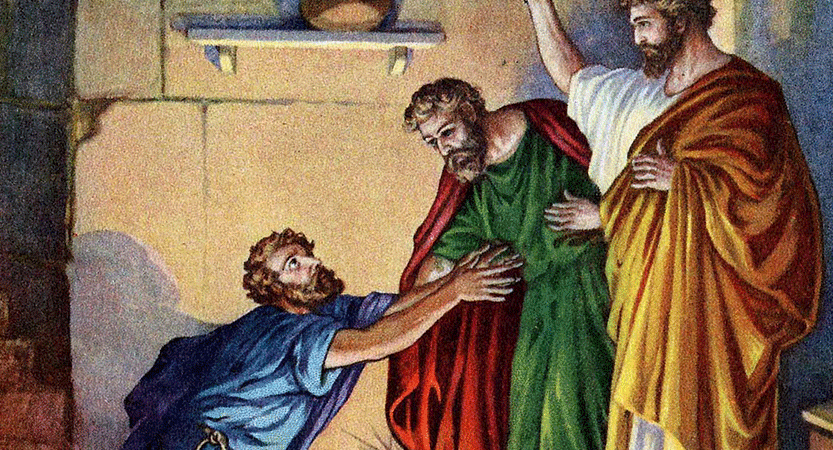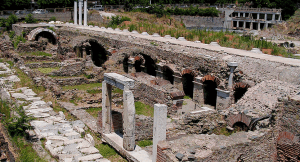Today we’ll finally resume our study of Acts 17. As always, the best way to understand a passage of Scripture is to study its context. For my last three posts pertaining to this study, I wrote about the person and character of the apostle Paul. Now we’ll briefly examine one of Paul’s companions, Silas.
[Aside from Scripture, my primary source material is an article in Zondervan’s five-volume Pictorial Encyclopedia of the Bible. If you don’t own a physical copy, you can find the same article in the digital version, Encyclopedia of the Bible, in the Resources available through Bible Gateway.]
Silas as Leading Man Among Brethren
Silas appears nowhere in the New Testament except the book of Acts. He first comes into view in chapter 15 and makes his final appearance in chapter 18. However, from the very beginning of his presence on the Biblical stage, Silas plays an impressive role.
His grand entrance came as a result of what scholars often call the Jerusalem conference. In this conference, the apostles recognized that God was indeed calling Gentiles into His church. They also determined that Gentile converts need not follow all the ritual laws pertaining to the Jews.
After a tumultuous meeting characterized by “much debate” (Acts 15:7), the apostles and elders in Jerusalem sent Judas called Barsabbas and Silas with Paul and Barnabas on their return to Antioch (verse 22). That same verse refers to Judas and Silas as “leading men among the brethren.” In addition, these men were known as prophets (verse 32).
The next verse sheds light on the part Judas and Silas played, explaining that these men received a commission to carry a letter from the conference to Antioch. The letter itself, recorded in the chapter, summarizes the decision of the apostles and elders, but the passage goes on to point out that Judas and Silas “will also report the same things by word of mouth” (verse 27). The church entrusted these men with the task of explaining the details and rationale of the apostolic decision. This issue had been a divisive one among the early church. This first mention of Silas makes it clear that the apostles had entrusted him with a critical responsibility.
Silas – Missionary Traveling Companion
Barnabas had been Paul’s companion during Paul’s first “missionary journey,” which had taken place before the Jerusalem conference. This partnership was not to continue in subsequent journeys. After a “sharp contention” (Acts 15:39), Paul and Barnabas parted company. They disagreed about whether they should take John Mark with them. Barnabas traveled to Cyprus with Mark, and Paul left for Syria and Cilicia with a new traveling companion, Silas.
Luke, the author of the book of Acts, mentions Silas 12 times. All these references correspond to Paul’s second “missionary journey.” Throughout most of this excursion, Silas stayed by Paul’s side, sharing a beating and imprisonment in Philippi (Acts 16:22-24), the miraculous conversion of the jailer (verses 25-33), and a nighttime escape from an angry mob in Thessalonica (Acts 17:5-10) to Berea.
They parted ways after Jews from Thessalonica began stirring up the crowds in Berea. Paul left both Silas and Timothy behind (verses 13-14), heading to Athens. Silas and Timothy eventually caught up with Paul in Corinth (Acts 18:5). This verse is the last to mention Silas.
Is There More to the Story of Silas?
Silas had a reputation as a significant leader in the early church. Why, then, does he drop out of the picture at the end of Paul’s second journey? Many scholars believe there may be more to the story.
The name Silas is Greek, and probably a contraction of Silouanos, which is a transliteration of the Latin Silvanus. This leads to the conjecture that the Silas of the book of Acts is the Silvanus Paul mentions in three of his letters and Peter mentions in one of his.
Paul wrote of a time when he and Silvanus and Timothy (2 Corinthians 1:19) preached the gospel to the Corinthians. Acts does not mention Silvanus in any of Paul’s journeys. It does describe Silas and Timothy catching up with Paul in Corinth, as noted above.
Silvanus appears in Paul’s greetings in both of his letters to the church at Thessalonica. Remember, this was the very same city from which Paul and Silas made their nighttime escape. The greeting in both books is identical: “Paul and Silvanus and Timothy, to the church of the Thessalonians” (1 Thessalonians 1:1; 2 Thessalonians 1:1). Most scholars believe Paul wrote both these letters from Corinth, where Silas and Timothy caught up with Paul. Scholars also believe the composition dates for the two letters were only months apart.
Another Apostle, Another Role
The final letter that mentions Silvanus (a.k.a. Silas) is 1 Peter, but not in the greeting (1 Peter 1:1-2). The final three verses of the book may be a sort of appendix Peter added. Scholars suggest that Silvanus actually composed the letter on Peter’s behalf (1 Peter 5:12-14). In the First Century it was common for an individual to have an amanuensis (or scribe) assist in writing a letter or other document.
This individual might do nothing more than record the words he heard, but some such scribes functioned as editors. A third group of these individuals had freedom to choose the particular wording within guidelines provided by the employer. We don’t know how much latitude Peter gave Silvanus. Since he was a “faithful brother,” and may well have been the “leading man among brethren” mentioned earlier, he could have had considerable freedom. It is clear that Silas / Silvanus did not disappear from the scene, but continued to serve the church.
What are your thoughts about Silas? Have you learned anything new in your study that you’d like to share? Please feel free to comment below.
In my next post we’ll take a look at Timothy. Also, please bear in mind that right now we are merely gathering facts. Much of what we learn may not have a direct bearing on our understanding. Even so, it’s better at this stage of our study to err on the side of gathering too much information rather than leaving out some critical piece of information.




